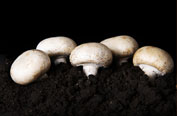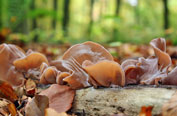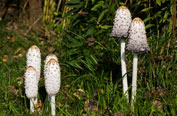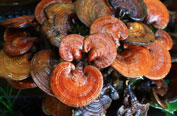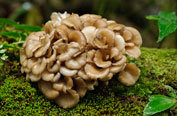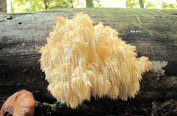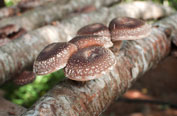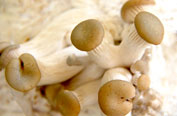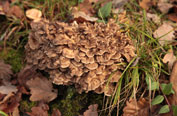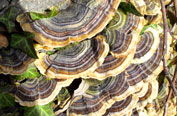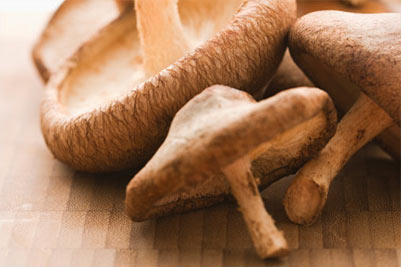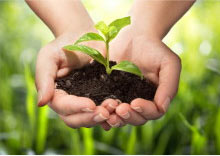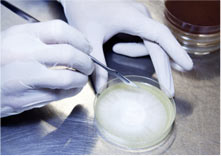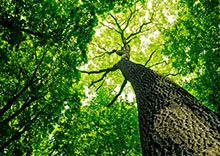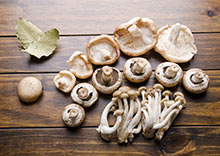
The life cycle of a mushroom
Hearing of mushrooms, pictures of aerial fruiting bodies form in one's mind, though the ordinary disremembered subterrestrial part of this organism, the mycelium, outranges the visual parts by far. Most of the fruiting bodies are divided into stem and cap with gills (gilled mushrooms – i. e. white button champignon mushrooms), ducts (Boletales – i. e. porcini or cep mushrooms) or pores (Polyporales – i. e. Reishi). In the gills, ducts or pores, spores (the “seed” of mushrooms) are being produced. Once fully developed the spores are released.
Introduction to cultivating mushrooms
Due to the lack of scientific knowledge fungi were classified as plants for a long time. Today's understanding of genetic and physiological facts show that fungi are more closely related to animals than plants. Unlike plants they neither are able to carry out photosynthesis nor can they produce the carbohydrates they need.
Mushrooms are dependent on organic carbohydrates, built up and provided by other creatures to feed themselves. In the life cycle of organic matter they operate as biodegradant destruents, who disintegrate organic material and dissolve soluble minerals.
Production of spore prints
Spores are the “seeds” of mushrooms. They are microscopic and are mainly produced at the under part of the cap. They are released at maturity. To collect the spores the fully developed caps are placed on a carrier material. The obtained spore print can be used to start a new mushroom culture. Placing spores on convenient substrate (most common are malt-agar substrates in petri dishes) induces mycelium growth.
Mushroom Cloning
(Level 3 – mushroom expert)
Gaining new cultures out of a fresh mushroom involves asexual reproduction. A mycelium achieved through cloning is called „pure culture“, it is genetically identical to the original mushroom. The successful breeding of a mycelium out of spores on the other hand is the way of sexual reproduction- the creation of a new organism with a new genetic code. When working with pure cultures, only one individual develops on the substrate, so there will be no competition for nutrients, leading to a higher and well predictable yield with stable quality.
Mycelium germination from spores
(Level 3 – mushroom expert)
When growing mushrooms out of spores you obtain plenty of autonomous mycelia strands forming dikaryotic mycelium, a so called spore mass inoculation. This mycelium has sprung from various germinating spores, sprouting mushroom cultures comprise individuals, descending from different mycelia strands (you can compare this mycelium to a fruit orchard – yielding heterogeneous fruits from different trees– not similar fruits from only one tree). Multicultural mycelium is mainly used for selecting the fittest individuals from the new culture to continue work with them.
Preparation of Agar – medium in petri dishes
The following formula makes 1 L of “MEA” – malt extract agar medium, convenient for most species of cultivatable mushrooms. Especially for working with spores, antibacterial agar media is recommended. Ready-to-use formulas are offered that only need to be mixed with water.
Selection of mycelium strains
(Level 3 – mushroom expert)
If you cultivate mushroom mycelium on agar medium there will appear different forms of mycelium. The two main forms are: rhizomorph mycelium and 'fluffy' mycelium (looks like cotton). For further cultivation and introduction of fruiting only the rhizomorph mycelium is suitable. The rhizomorph mycelium looks like the roots of plants. The primordia, later to become fruit bodies, are built from it. If you cultivate mushroom cultures on petri dishes, you have to select the rhizomorph mycelium from the fluffy. Only the rhizomorph growing mycelium is used for further cultivation.
Inoculating wood substrates with grain spawn
(Level 2 - advanced cultivator)
Most fungi do not develop fruiting bodies on rye grain substrate, that's why an adequate fruiting substrate must be inoculated with grain spawn. This method is suitable for most wood-inhabiting mushroom species.
Perform this working step under aseptic conditions to prevent contamination. Clean your worktop, wash hands and forearms, put on face mask, hairnet and gloves and disinfect your worktop well.
Sterilising rye substrate for grain spawn
(Level 2 - advanced cultivator)
In mushroom cultivation cereal substrate is being used to produce grain spawn. This production stage is mainly used to expand the mycelium mass that you get from the agar- for the inoculation of fruiting substrates. Soak the rye in 167°F/ 75°C warm water, allow the water level to be 4 – 5 cm higher and leave it in the tub overnight (12 - 18 hours). Put the soaked rye grain into a sieve and let it drain for about 15 minutes, then put it into the mixing container.
Inoculation of grain spawn with mycelium on agar medium
(Level 3 – mushroom expert)
Perform this working step as aseptic as possible to prevent contamination of the grain by bacteria or mould. Clean your worktop, wash hands and forearms, put on face mask, hairnet and gloves and disinfect your worktop well. Use the mycelium of 1 petri dish for inoculating 1 jar of sterilised grain (about 400 grams of substrate), for grain in a bag take more petri dishes. Avoid inoculation of 1 grain substrate with different mycelium strains; use only copies of the same clone per jar/bag.
nike flex contact boys shoes gray - Nike Air Force 1 Shadow Cashmere/Pale Coral - Pure Violet CI0919 - 700 | nike kd 7 ext long tail black line for sale - 401 – Ietp - New Air Jordan 1 High OG OSB DIAN Blue Chill Sorrowful CD0463
Sterilisation of wood substrate
(Level 2 - advanced cultivator)
Most fungi do not develop fruiting bodies on rye grain substrate, that is why an adequate fruiting substrate must be inoculated with the grain spawn. In this chapter we want to introduce a standard substrate suitable for a wide range of wood-inhabiting mushrooms. Let the wood chips soak in cold water overnight (12-18h). Use as much water until all the chips are floating. Put the soaked wood chips in to a sieve and let drain for around 15 minutes.
„PF-technique“
(Level 1 – beginners)
The PF-technique aka BRF-Tek (Brown Rice Flour technique) is a method developed by hobby mushroom cultivators for growing mushrooms in the simplest way. Over the last decades many different versions of this method have developed. The following instruction is based on our experience. Mushrooms need a convenient substrate to develop fruit bodies. The substrate has to be produced under sterile conditions to avoid contamination through mold or bacteria.
Inoculation of substrate bags with spore syringes
(Level 1 – beginners)
This is a very simple method of mushroom cultivation and suitable for hobby-mycologists. Use a convenient substrate, depending on the mushroom species you want to cultivate. Detailed information about the convenient substrate can be found in the product description of our spores. When you bring spores onto an appropriate nutrient medium, the spores start to germinate. As soon as the substrate is fully colonised by the mushroom, you can set up the bag for fruiting.
Production of spore syringes
(Level 2 - advanced cultivator)
Spore syringes contain spores dissolved in water and are used to inoculate substrates. Hobby-mycologists tend to work with spore syringes, because even if used in a not 100 % sterile environment, the substrates are seldom contaminated. It’s rather easy to produce small to medium amounts of substrates or grain spawn with spore syringes. If you inoculate substrates with a spore syringe, you get a “Multi-culture” (look up “Growing mycelium out of spores”), which mostly results in less crop yield, compared to the use of selected rhizomorph mycelium strains.
Laying of a mushroom bed
(Level 1 – beginner)
Preparing a mushroom bed with wood-inhabitant mushrooms is a very easy thing! The best time to start is spring, as soon as the nights are frost-free. We recommend the use of wood-based spawn (spawn describes a substrate that is fully colonised by mushroom mycelium, used for inoculation of the fruiting substrate). The use of grain-based spawn may attract mice, rats or other vermin. Just mix the spawn with a convenient base material and keep it moist.
Inoculation of wood logs with spawn dowels
(Level 1 – beginner)
The inoculation of wood logs or stumps with spawn dowels can be done throughout the whole year, if the logs/stumps are stored frost-free during spawn run, until they are fully colonised. Depending on the species, the mushroom fruits for several seasons until all the nutrients in the wood have been consumed. The quality of the wood is crucial for successful cultivation. After you have cut the wood, make sure to store it in a dry place for 2-3 weeks, then prepare it as follows:
Mushroom cultivation on a bale of straw
(Level 1 – beginner)
Several mushroom species are straw-inhabitants. You can use wheat-, rye- or barley straw. One of the most successful ways for these species is the cultivation on bales of straw in the garden. Only use dry and high-quality bales of straw, because the quality of the fruiting substrate always has a major influence on the crop yield. The colour of the straw (golden yellow) and the almost tear-proof blades indicate the health of the straw.
Instructions for indoor mushroom propagator
For successful growth mushrooms need a suitable substrate, the right temperature and humidity, as well as oxygen and a little light. Our grow-kits are designed to provide these cultivation parameters in an easy-to-handle way. It is easy to upgrade a customary greenhouse into a hobby-mushroom-grow-set. The main principle always stays the same, no matter in how much space you cultivate, only the machinery used to regulate the climatic conditions gets more complex, the more space you occupy.

